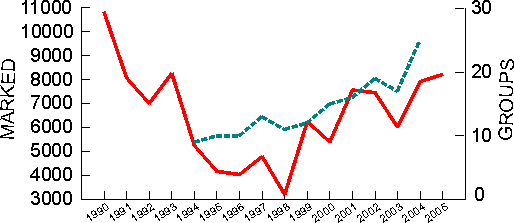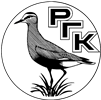Ringing of waders
This post is also available in: Русский (Russian)
Moscow Bird Ringing Center, Moscow, 117312, Russia, e-mail: bird.ring.rus@gmail.com, Phone: +7(499)783-3226
What for to ring birds?Ringing is marking of birds with standard metal bands that have unique numbers and put on bird legs. Information about marked bird can be obtained by reading ring number which usually becomes possible on re-capture, finding of dead bird or under favourable circumstances by reading of the number in a powerful field scope. Ringing is an old and approved approach to study bird migration, which 100th anniversary was celebrated in 1999 by ornithologists. Until recent time ringing was the only technique available to track accurately long-distance movements of animals. Currently radio- and satellite transmitters are being used to study animal movements, but ringing still remains an important complement to new inventions. Apart of studies of migratory links ringing is also used for getting information about speed of migration, population and demographic parameters in birds (e.g. life longevity, area and mate fidelity), moult rate and other biological parameters in individual birds. Apart of academic value of this knowledge it is essential for efficient conservation of birds based on information about population structure, migration routes and timing, mortality, etc.
Inspite of impressive financial and labour efforts put into ringing by ornithologists, worldwide accumulation of resulting scientific data in national ringing centers occurs at a very low rate. This is due to small chances of recovery of a ringed bird by public, and to small reporting rate of recoveries from less-developed countries where much of bird hunting actually occurs.
Ringing of waders in USSR and Commonwealth of Independent States (CIS). The WGW has given high priority to exchange of information related to ringing activities due to importance of these studies. The first issues of the “Information Materials of the WGW” contained articles summarizing long-term ringing studies in several regions of the former USSR, while annual summaries of activities on wader ringing across the CIS have appeared in bulletin since 1990. Several teams of ornithologists have ringed annually thousands of waders each in 1980s (Institute of Zoology of the Academy of Sciences of Kazakhstan, Odessa and Krasnoyarsk Universities), but these activities have decreased dramatically after collapse of the Soviet Union and decline of domestic science in 1990s. Total numbers of ringed waders have started to increase in late 1990s (Figure), but still did not reach the level of 1980s. The highest numbers of waders are being ringed during the recent years on the Azov-Black Sea Ornithological Station (Melitopol, the Ukraine) and Institute of Zoology of the Academy of Sciences of Belarus (Minsk).

Some results of wader ringing. Recoveries of rings, i.e. repeated registrations of ringed birds, have been accumulated in the Moscow Bird Ringing Center for most of the 20th century and recently also in analogous offices created in several state capitals of the CIS. Analysis and publication of ringing outputs is an important task, conducted mainly by ringing centers. M.A. Lebedeva was the first who summarized and published domestic information on wader migrations based on ringing data (e.g., Lebedeva 1965, 1974). The most fundamental review of the accumulated data was undertaken by an international team of authors in a series “Migrations of birds of Eastern Europe and Northern Asia” (Ilyichev, Mikhelson 1985), although it did not include the whole list of wader species of the former USSR and has become dated to a certain extent by the current time. Apart of these publications several papers summarized and analyzed ringing data when reviewing migration of individual species or populations of waders (e.g., Bianki 1967, Lambeck et al. 1995). Several papers brought together information on migratory links of waders of some regions (e.g., Tomkovich et al. 2000, Tomkovich 2003). V.V. Gavrilov (1991) reviewed information on records in life longevity of waders.
Cited literature
Bianki V.V. 1967. Waders, gulls and auks of the Kandalaksha Bay. – Trans. of the Kandalaksha State Nature Reserve. Issue 6. Murmansk Publ. 364 p. (in Russian).
Gavrilov V.V. 1991. Maximal live longevity in wild waders – dependence on body mass. News of the Acad. Sci. USSR. Series of Biol. Sci., # 3. P. 471-473. (in Russian).
Ilyichev V.D. & Mikhelson K. A. (eds.) 1985. Migrations of birds of Eastern Europe and Northern Asia: Gruiformes-Charadriiformes. Moscow: Nauka. 304 p. (in Russian).
Lebedeva M.A. 1965. Migrations of waders based on ringing data. – Ornithologia. Vol. 7. Moscow: Moscow Univ. Press. P. 328-340. (in Russian).
Lebedeva M.A. 1974. On transcontitental connections of some waders of Siberia. – Ornithologia. Vol. 11. Moscow: Moscow Univ. Press. P. 298-306. (in Russian).
Lambeck R.H.D., Bianki V.V., Schekkerman H., Wessel E.G.J., Herman P.M.J. & Koryakin A.S. 1995. Biometrics and migration of Oystercatchers (Haematopus ostralegus) from the White Sea region (NW Russia). – Ringing & Migration 16: 140-158.
Tomkovich P.S., Lappo E.G. & Syroechkovski E.E., Jr. 2000. Ringing and migratory links of Taimyr waders. – Heritage of the Russian Arctic: Research, conservation and international co-operation. Eds.: B.S.Ebbinge, Yu.L.Mazurov, P.S.Tomkovich. Moscow: Ecopros Publishers. Pp. 458-475.
Tomkovich P.S. 2003. List of wader species of Chukotka, Northern Far East of Russia: their banding and migratory links. – The Stilt 44: 29-43.


